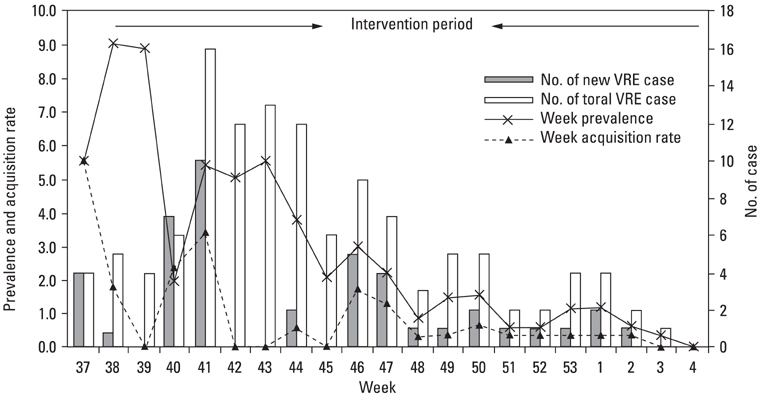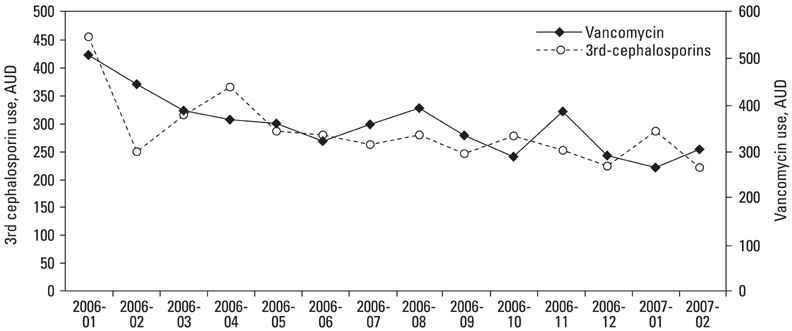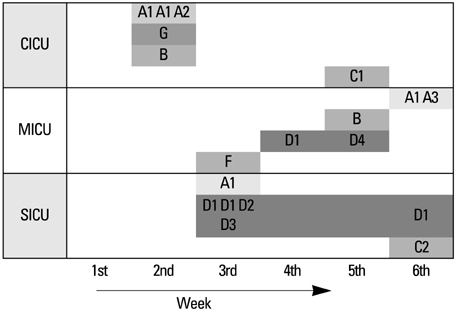Yonsei Med J.
2009 Oct;50(5):637-643. 10.3349/ymj.2009.50.5.637.
Epidemiology and Control of an Outbreak of Vancomycin-Resistant Enterococci in the Intensive Care Units
- Affiliations
-
- 1Division of Infectious Diseases, Department of Internal Medicine, Korea University College of Medicine, Seoul, Korea. macropha@korea.ac.kr
- 2Institute of Emerging Infectious Diseases, Korea University College of Medicine, Seoul, Korea.
- 3Department of Laboratory Medicine, Korea University College of Medicine, Seoul, Korea.
- 4Infection Control Unit, Korea University College of Medicine, Seoul, Korea.
- KMID: 1103816
- DOI: http://doi.org/10.3349/ymj.2009.50.5.637
Abstract
- PURPOSE
This study was aimed to describe a vancomycin-resistant enterococci (VRE) outbreak across three intensive care units (ICUs) of a Korean hospital from September 2006 to January 2007 and the subsequent control strategies. MATERIALS AND METHODS: We simultaneously implemented multifaceted interventions to control the outbreak, including establishing a VRE cohort ward, active rectal surveillance cultures, daily extensive cleaning of environmental surfaces and environmental cultures, antibiotic restriction, and education of hospital staff. We measured weekly VRE prevalence and rectal acquisition rates and characterized the VRE isolates by polymerase chain reaction (PCR) of the vanA gene and Sma1-pulsed-field gel electrophoresis (PFGE). RESULTS: During the outbreak, a total of 50 patients infected with VRE were identified by clinical and surveillance cultures, and 46 had vancomycin-resistant Enterococcus faecium (VREF). PFGE analysis of VREF isolates from initial two months disclosed 6 types and clusters of two major types. The outbreak was terminated 5 months after implementation of the interventions: The weekly prevalence rate decreased from 9.1/100 patients-day in September 2006 to 0.6/100 by the end of January 2007, and the rectal acquisition rates also dropped from 6.9/100 to 0/100 patients-day. CONCLUSION: Our study suggests that an aggressive multifaceted control strategy is a rapid, effective approach for controlling a VRE outbreak.
MeSH Terms
Figure
Cited by 2 articles
-
Comparison of Antibiotic Resistance Rate of Medically Important Microorganisms between Japan and Korea
Keigo Shibayama, Hyukmin Lee, Sunjoo Kim
Ann Clin Microbiol. 2015;18(4):111-118. doi: 10.5145/ACM.2015.18.4.111.Evaluation of the Usefulness of Selective Chromogenic Agar Medium (ChromID VRE) and Multiplex PCR Method for the Detection of Vancomycin-resistant Enterococci
Do-Hoon Kim, Jae-Hee Lee, Jung-Sook Ha, Nam-Hee Ryoo, Dong-Seok Jeon, Jae-Ryong Kim
Korean J Lab Med. 2010;30(6):631-636. doi: 10.3343/kjlm.2010.30.6.631.
Reference
-
1. Bhavnani SM, Drake JA, Forrest A, Deinhart JA, Jones RN, Biedenbach DJ, et al. A nationwide, multicenter, case-control study comparing risk factors, treatment, and outcome for vancomycin-resistant and -susceptible enterococcal bacteremia. Diagn Microbiol Infect Dis. 2000. 36:145–158.2. Lee K, Jang SJ, Lee HJ, Ryoo N, Kim M, Hong SG, et al. Increasing prevalence of vancomycin-resistant Enterococcus faecium, expanded-spectrum cephalosporin-resistant Klebsiella pneumoniae, and imipenem-resistant Pseudomonas aeruginosa in Korea: KONSAR study in 2001. J Korean Med Sci. 2004. 19:8–14.3. Oh HS, Kim EC, Oh MD, Choe KW. Outbreak of vancomycin resistant enterococcus in a hematology/oncology unit in a Korean University Hospital, and risk factors related to patients, staff, hospital care and facilities. Scand J Infect Dis. 2004. 36:790–794.4. Yoo SJ, Sung H, Cho YU, Kim MN, Pai CH, Kim YS. Role of horizontal transfer of the transposon Tn1546 in the nosocomial spread of vanA vancomycin-resistant enterococci at a tertiary care hospital in Korea. Infect Control Hosp Epidemiol. 2006. 27:1081–1087.
Article5. Recommendations for preventing the spread of vancomycin resistance. Recommendations of the Hospital Infection Control Practices Advisory Committee (HICPAC). MMWR Recomm Rep. 1995. 44:1–13.6. Muto CA, Jernigan JA, Ostrowsky BE, Richet HM, Jarvis WR, Boyce JM, et al. SHEA guideline for preventing nosocomial transmission of multidrug-resistant strains of Staphylococcus aureus and enterococcus. Infect Control Hosp Epidemiol. 2003. 24:362–386.
Article7. WHO Collaborating Centre for Drug Statistics Methodology. ATC Index with DDDs. 2001. Norway: WHO.8. Dutka-Malen S, Evers S, Courvalin P. Detection of glycopeptide resistance genotypes and identification to the species level of clinically relevant enterococci by PCR. J Clin Microbiol. 1995. 33:24–27.
Article9. Murray BE, Singh KV, Heath JD, Sharma BR, Weinstock GM. Comparison of genomic DNAs of different enterococcal isolates using restriction endonucleases with infrequent recognition sites. J Clin Microbiol. 1990. 28:2059–2063.
Article10. Tenover FC, Arbeit RD, Goering RV, Mickelsen PA, Murray BE, Persing DH, et al. Interpreting chromosomal DNA restriction patterns produced by pulsed-field gel electrophoresis: criteria for bacterial strain typing. J Clin Microbiol. 1995. 33:2233–2239.
Article11. Nelson RR, McGregor KF, Brown AR, Amyes SG, Young H. Isolation and characterization of glycopeptide-resistant enterococci from hospitalized patients over a 30-month period. J Clin Microbiol. 2000. 38:2112–2116.
Article12. de Lencastre H, Brown AE, Chung M, Armstrong D, Tomasz A. Role of transposon Tn5482 in the epidemiology of vancomycin-resistant Enterococcus faecium in the pediatric oncology unit of a New York City Hospital. Microb Drug Resist. 1999. 5:113–129.
Article13. Byers KE, Anglim AM, Anneski CJ, Germanson TP, Gold HS, Durbin LJ, et al. A hospital epidemic of vancomycin-resistant Enterococcus: risk factors and control. Infect Control Hosp Epidemiol. 2001. 22:140–147.
Article14. Noskin GA, Stosor V, Cooper I, Peterson LR. Recovery of vancomycin-resistant enterococci on fingertips and environmental surfaces. Infect Control Hosp Epidemiol. 1995. 16:577–581.
Article15. Zachary KC, Bayne PS, Morrison VJ, Ford DS, Silver LC, Hooper DC. Contamination of gowns, gloves, and stethoscopes with vancomycin-resistant enterococci. Infect Control Hosp Epidemiol. 2001. 22:560–564.
Article16. Kurup A, Chlebicki MP, Ling ML, Koh TH, Tan KY, Lee LC, et al. Control of a hospital-wide vancomycin-resistant Enterococci outbreak. Am J Infect Control. 2008. 36:206–211.17. McCarthy KM, Van Nierop W, Duse A, Von Gottberg A, Kassel M, Perovic O, et al. Control of an outbreak of vancomycin-resistant Enterococcus faecium in an oncology ward in South Africa: effective use of limited resources. J Hosp Infect. 2000. 44:294–300.
Article18. Christiansen KJ, Tibbett PA, Beresford W, Pearman JW, Lee RC, Coombs GW, et al. Eradication of a large outbreak of a single strain of vanB vancomycin-resistant Enterococcus faecium at a major Australian teaching hospital. Infect Control Hosp Epidemiol. 2004. 25:384–390.19. Hachem R, Graviss L, Hanna H, Arbuckle R, Dvorak T, Hackett B, et al. Impact of surveillance for vancomycin-resistant enterococci on controlling a bloodstream outbreak among patients with hematologic malignancy. Infect Control Hosp Epidemiol. 2004. 25:391–394.
Article20. Jochimsen EM, Fish L, Manning K, Young S, Singer DA, Baker R, et al. Control of vancomycin-resistant enterococci at a community hospital: efficacy of patient and staff cohorting. Infect Control Hosp Epidemiol. 1999. 20:106–109.
Article21. Siddiqui AH, Harris AD, Hebden J, Wilson PD, Morris JG Jr, Roghmann MC. The effect of active surveillance for vancomycin-resistant enterococci in high-risk units on vancomycin-resistant enterococci incidence hospital-wide. Am J Infect Control. 2002. 30:40–43.
Article22. Lucet JC, Armand-Lefevre L, Laurichesse JJ, Macrez A, Papy E, Ruimy R, et al. Rapid control of an outbreak of vancomycin-resistant enterococci in a French university hospital. J Hosp Infect. 2007. 67:42–48.
Article23. Hendrix CW, Hammond JM, Swoboda SM, Merz WG, Harrington SM, Perl TM, et al. Surveillance strategies and impact of vancomycin-resistant enterococcal colonization and infection in critically ill patients. Ann Surg. 2001. 233:259–265.
Article24. Brown AR, Amyes SG, Paton R, Plant WD, Stevenson GM, Winney RJ, et al. Epidemiology and control of vancomycin-resistant enterococci (VRE) in a renal unit. J Hosp Infect. 1998. 40:115–124.
Article25. Quale J, Landman D, Saurina G, Atwood E, DiTore V, Patel K. Manipulation of a hospital antimicrobial formulary to control an outbreak of vancomycin-resistant enterococci. Clin Infect Dis. 1996. 23:1020–1025.
Article26. Edmond MB, Ober JF, Weinbaum DL, Pfaller MA, Hwang T, Sanford MD, et al. Vancomycin-resistant Enterococcus faecium bacteremia: risk factors for infection. Clin Infect Dis. 1995. 20:1126–1133.
Article27. Handwerger S, Raucher B, Altarac D, Monka J, Marchione S, Singh KV, et al. Nosocomial outbreak due to Enterococcus faecium highly resistant to vancomycin, penicillin, and gentamicin. Clin Infect Dis. 1993. 16:750–755.
Article28. Morris JG Jr, Shay DK, Hebden JN, McCarter RJ Jr, Perdue BE, Jarvis W, et al. Enterococci resistant to multiple antimicrobial agents, including vancomycin. Establishment of endemicity in a university medical center. Ann Intern Med. 1995. 123:250–259.
Article29. Wells CL, Juni BA, Cameron SB, Mason KR, Dunn DL, Ferrieri P, et al. Stool carriage, clinical isolation, and mortality during an outbreak of vancomycin-resistant enterococci in hospitalized medical and/or surgical patients. Clin Infect Dis. 1995. 21:45–50.
Article30. Farr BM, Salgado CD, Karchmer TB, Sherertz RJ. Can antibiotic-resistant nosocomial infections be controlled? Lancet Infect Dis. 2001. 1:38–45.
Article
- Full Text Links
- Actions
-
Cited
- CITED
-
- Close
- Share
- Similar articles
-
- Control of Vancomycin-resistant Enterococci (VRE) in Intensive Care Units
- Resistance Mechanism and Epidemiology of Vancomycin-resistant Enterococci
- Transplantation of a kidney from a donor with vancomycin-resistant Enterococci
- Rapid Screening of Vancomycin Resistant Enterococci with Chromogenic Agar (ChromID VRE)
- Factors Influencing Level of Awareness and Compliance with Vancomycin-Resistant Enterococcus Infection Control among Nurses in Intensive Care Units




